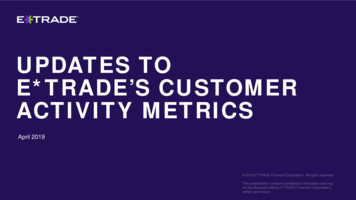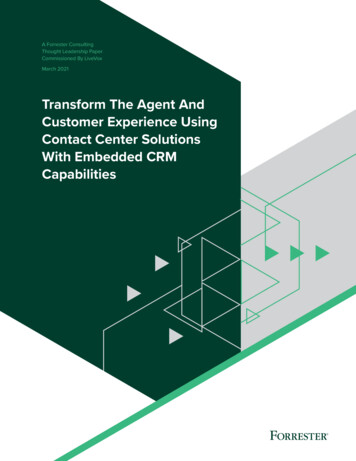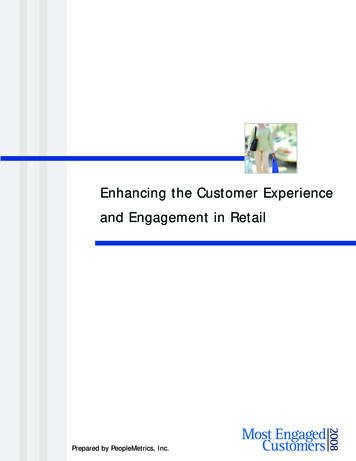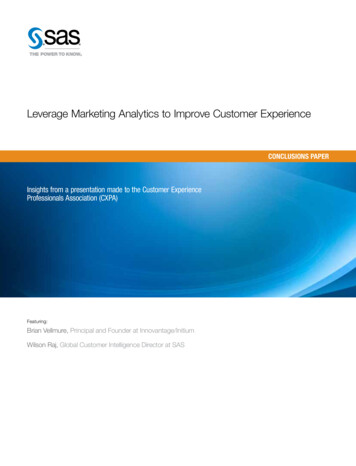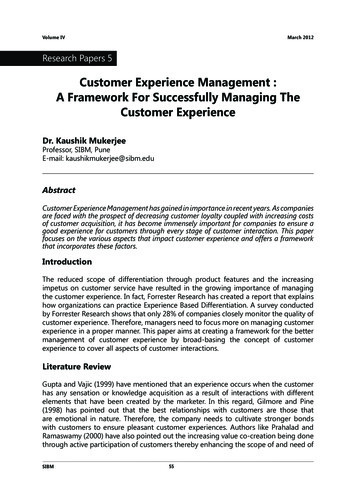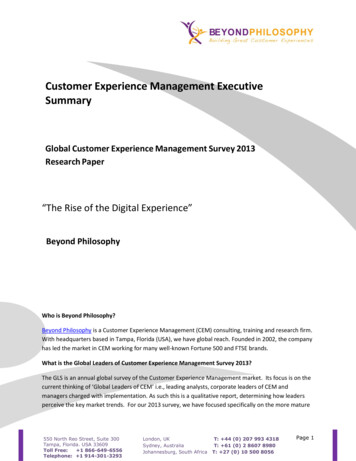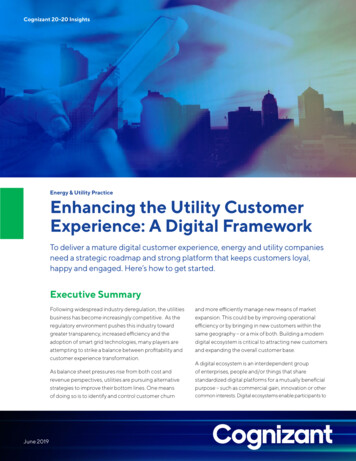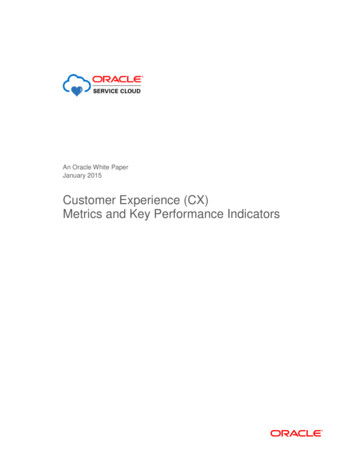
Transcription
An Oracle White PaperJanuary 2015Customer Experience (CX)Metrics and Key Performance Indicators
CX Metrics and KPIsExecutive Overview . 2The CX Value Equation . 2Three CX Practice Areas . 3#1 Acquisition . 3#2 Retention . 4#3 Efficiency . 4Metrics for the Nine Important CX Business Challenges . 5Table 1: Metrics for 9 Important CX Business Challenges . 5CX Metrics . 5#1 Acquisition . 6#2 Retention . 9#3 Efficiency . 11Conclusions . 13Author. 13
CX Metrics and KPIsExecutive OverviewThis document aligns to the Customer Experience (CX) Value Equation defined by Oracle as amethod to identify and measure the value of CX. Within the value equation there are threeimportant areas of business focus, or CX practice areas: Acquisition, Retention, and Efficiency.Each area has strategic and operational areas of measurement, or Key PerformanceIndicators (KPIs).This guide has been written for the business leader or analyst who would like to identify ormeasure those critical CX measurement points that provide feedback on the health andsuccess of a CX initiative. This guide is intended to familiarize you with important CXmeasurements and Key Performance Indicators (KPIs) along with providing a definition and amethod to calculate their value to your business. In many respects, this could be considered adictionary of CX KPIs.This guide does not provide detail on how to start tracking these measurements, nor how toidentify target numbers that make sense for your organization. But rather, this documentdefines which business metrics should be considered when thinking about CX and the effect itcould have on your business.The CX Value EquationCustomer Experience (CX) is a complex practice area that requires clear vision, the right tools,and great execution to succeed. Oracle recommends thinking about CX in terms of threemajor areas: Acquisition (A), Retention (R), and Efficiency (E). These areas play a critical rolein any business, whether it’s listed on a stock exchange, publically or privately owned andeven non-for-profit or government organizations. When combined, we refer to these threeareas as the CX Value Equation:CX A R EAcquisition refers to the ability of an organization to increase itscustomer base;Retention is the ability of an organization to keep and grow thecustomers it already has; andEfficiency allows an organization to do more with less.2
CX Metrics and KPIsThe CX Value Equation effectively defines a mapping or translation layer between a CXstrategy and the organization’s profit line. It facilitates the conversations about CXinvestments, priorities and returns on investment.Three CX Practice AreasThe CX Value Equation consists of three main practice areas: Acquisition, Retention, andEfficiency. These CX practice areas are explored here along with the primary businesschallenges for each area. Each CX practice area has three identified business challenges,yielding a total of nine CX business challenges for success.RETENTIONEFFICIENCY(INCREASE GENERATE MOREOPPORTUNITIESINCREASE SHAREOF WALLETINCREASEROIC / EVAINCREASEBRAND ET SHAREDRIVEADVOCACYDECREASECOST OF OPERATIONSACQUISITIONIn the remainder of this document we will explore each of these in more detail, to begin withlet’s indentify the key business challenges for each of these areas.#1 AcquisitionAcquisition focuses on how an organization can increase its customer base by gaining new oradditional customers; Acquisition can be decomposed into three business challenges:1) Generate More Opportunities is the first challenge of acquisition. More opportunitiesare generated through an increase the amount of visitor and customer traffic (eitherphysically at a store or virtually to a web-site) so that there are additional situations forsales transactions. Organizations benefit from having a respected brand and frombeing highly visible and by creating great customer experiences.2) Increasing Brand Equity is a key objective of most companies. Increasing BrandEquity builds corporate value, and can influence key sales and customer3
CX Metrics and KPIsmeasurements such as increasing the average value of an order, improving customerconversion rates and driving higher revenues.3) Increase in Market Share provides companies with sustainability, growth, and pricingpower. Improving market share typically leads to an overall better financial position forcompanies.#2 RetentionRetention focuses on how organizations keep their customers, to reduce churn and toincrease their life-time value. There are three important business challenges associated withRetention:1) The first challenge is to create customer Loyalty. A customer who is loyal is one whoresists switching to another brand or to doing business with another organization.2) Drive Advocacy is a desired result that goes beyond loyalty. In the social age,advocacy is a key component of any company’s success measurement. A customeradvocate is one who tells their friends, family, or colleagues about how much theyenjoy doing business with the organization.3) Increasing the Share of Wallet for each customer drives higher profit. Expandingsales through expansion of sales to each customer is one of the best and mostprofitable approaches to increasing revenues.#3 EfficiencyEfficiency focuses on doing the right operational activity to deliver the desired results at alower cost to the organization. There are also three important business challenges in this area:1) Increase Return on Invested Capital (ROIC) or Economic Value Add (EVA), bothare key measures of a company’s efficiency. Increases in these areas typicallyindicate a strengthening of the company’s financial position.2) The major challenge represents traditional accounting of the expenses associated withthe customer interaction and Decreasing the Cost of Operations. These expensesrefer to those costs associated with servicing the customer base either before theypurchase a product or after.4
CX Metrics and KPIs3) At most organizations, the largest cost associated with doing business is itsemployees. Improving the Productivity of this asset can go a long way towardimproving the overall impact that employees can have, and in delivering a greatcustomer experience.Metrics for the Nine Important CX Business ChallengesEach of the business challenges discussed above has associated measurements thatorganizations use to track the associated performance. These measures inform the business ifthere are any areas where the organization is currently underperforming and whereimprovements may be made, or if there are any areas of excellence. The summary of the nineare in the below table.Table 1: Metrics for 9 Important CX Business ChallengesThe Three CX AreasAcquisitionRetentionEfficiencyThe Nine Associated Business Challenges Generate More Opportunities Increase Brand Equity Increase Market Share Increase Share of Wallet Drive Loyalty Drive Advocacy Increase ROIC or EVA Increase Productivity Decrease Cost of OperationsCX MetricsThe purpose of this section is to itemize those measurements used by leading CXorganizations. While these measures are appropriate for a broad set of industries andbusiness models, we would suggest that maximum benefit can only be achieved by view thesethrough the lens of your own organization. Furthermore, you may need to indentify additionalmeasurements to supplement this list depending on these results.5
CX Metrics and KPIsTwo distinct but related types of measures are presented, namely “Strategic” and “Operational”KPIs. A Strategic KPI is one that will be of most interest to a top-level executive team, has atendency to aggregate related numbers or measurements, and provides high-level informationabout business performance. An Operational KPI may also be of interest to the top-levelexecutive team, but more likely will be used within a division or department for day-to-daymonitoring.#1 AcquisitionStrategic KPIsDirect Traffic Definition: All visitor (existing or new customer) traffic that occurs as a resultof a specific company action that is intended to drive interactions to thecompany. The visitor arrives by a defined course: “Company Activity drivesVisitor Interaction.” This includes things like company sponsored advertising,direct mail campaigns, intentional product Search Engine Optimization(SEO), email, telemarketing, company initiated tweets, facebook page, andother marketing efforts. To count as Direct Traffic, the interaction must bespecifically identified to a specific company activity. How to measure: Add up measurable traffic that is identified to directly driveactivity. This does not include Indirect Traffic or Unidentified Traffic Source.Indirect Traffic Definition: All visitor traffic that results from company activities intended toraise general awareness of the organization’s brand or products, but notnecessarily designed to initiate an interaction. The visitor arrives by acircuitous route: “Company Activity(ies) drives Intermediary Activity(ies) thatdrives Visitor Interaction.” Company activities could include productplacement in a movie, a viral marketing campaign, mobile apps, freemiumproducts, or general web traffic. Intermediary activities could include socialmedia activity (customer initiated tweets, likes on facebook), brand reputation(great CX reputation), and viral marketing. How to measure: Add up traffic from all sources that arrive via a circuitousroute.6
CX Metrics and KPIsUnidentified Traffic Source Definition: All visitor traffic that’s source of initiation can’t be specificallyidentified. Frequently the source of why the customer initiated an interactioncan’t be determined.How to measure: Add up traffic that can’t be specifically identified as Director Indirect.Brand Mentions Definition: The number of countable mentions (tweets, status updates, posts,comments, conversations, emails, etc) that occurred in a given time period.How to Measure: Tally of all observable mediums and add them together.Conversion Rate Definition: The percentage of interactions that result in a completed salestransaction. In practice, this number is typically decomposed by channel, product,or other segmenting factor. For example, in a contact center, the call isconsidered converted if the caller places an ordered – include only sales calls, notservice calls. A web page visit is considered converted if the visitor places theorder.How to measure: Total the number of completed sales transactions and divide bythe total number of interactions handled. In a contact center, this would be thetotal number of converted calls divided by the total number of sales calls – includeonly sales calls, not other calls such as service calls. On a web page, it is oftenmeasured with a custom configured 3rd party web analytics tool such as GoogleAnalytics or Omniture.Rate of Adoption Definition: This refers to the spread of an idea, technology or services in a givenculture or population.How to measure: First define what adoption means to the organization, and thentake the total number of adopted clients and divide by the total audience.Compare this number to itself over time for the “Rate” of Adoption.Average Order Value (AOV) Definition: The mean value (in monetary terms) for purchases. Typically thisnumber is reported both in aggregate but also by channel and by other segment.Frequently advanced organizations will calculate this on customer segment (e.g.income level, or geography)7
CX Metrics and KPIs How to measure: Take the total sales revenue / total number of sales transactionsfor the target customer group in question over a given time period.Operational KPIsMarketing Campaign Effectiveness Definition: Return on investment for a given campaign initiative. A campaignthat is highly effective will create a great deal more revenue for theorganization than it expends executing the campaign.How to Measure: (Net Campaign Revenue – MarketingInvestment)/Marketing InvestmentPages per Visit Definition: The average number of web pages which are viewed during a singlevisit to the website. More pages viewed frequently indicate higher engagement,which is a pre-cursor to a sale. However, caution must be taken to ensure that thesite is well structured with easy to find information, or an increase in pages viewedcould be a result of the visitor being unable to find the desired informationHow to measure: This is a standard measure in web analytics tools.Shopping Cart Abandonment Definition: The percentage of times that a potential shopper puts an item in a realor virtual shopping cart and then removes it or fails to complete a purchase.How to measure: This is typically measured through a custom configured 3rd partyanalytics tool.New vs. Returning Visitor %Definition: Refers to the mix between visitors who are new and visitors whopreviously visited and are now returning for another visit.How to measure: This is a standard measure in 3rd party analytics tool.Frequency of Visit Definition: The amount of repeat visits that are completed by a single customerover a given time period.How to measure: This is a standard measure in any 3rd party analytics toolItems per Order Definition: The average number of products or services that are added to a salesorder.8
CX Metrics and KPIs How to measure: The total number of unique items ordered divided by the totalnumber of orders.Up-Sell Cross-Sell Rate Definition: The number of people that accept an alternative or augmented offer.Up-Sell refers to an offer that is more beneficial to the company. Examples ofbeneficial Up-Sells could be a more expensive item, a higher profit item,disposition of stale merchandise. Cross-Sell refers to a related item to the originaldesired item. For example expedited delivery, insurance or accessories. EffectiveUp-Sell or Cross-Sell practices may increase the number of Items per Order aswell as the Average Order Value.How to measure: Take the number of people that accept an offer and divide bythe total number of offers made (sales attempts).Average Revenue per User (ARPU) Definition: The average revenue that a company derives from a single customer oruser over a given period of time.How to measure: Take the total amount of revenue generated and divide by thetotal number of unique users/customers.#2 RetentionStrategic KPIsCustomer Churn Rate Definition: The percentage of customers that do not remain loyal to theorganization either by failing to make a repeat purchase or by canceling theirservice.How to measure: The total number of lost or canceled customers divided by thetotal number of active customers over a given time period.Net Promoter Score (NPS) Definition: The percentage of customers that would recommend an organizationto their friends, family or colleagues.How to measure: Typically measured through customer survey. The singlequestion is “How likely are you to recommend X to a friend or colleague?” andhas an accompanying 0-10 scale. The Net Promoter Score is the percentage ofPromoters (9-10) minus the percentage of Detractor (0-6).9
CX Metrics and KPIsCustomer Satisfaction (CSAT) Definition: The mean satisfaction score of customers for a given experience.How to measure: Measured through a customer survey that asks customers to ratetheir satisfaction with X on a defined scale with adjectives that range from ‘Not atall satisfied’ to ‘Very Satisfied’. Often CSAT is measured by interaction type (aproduct return, a password change, a simple question, etc) through anautomatically generated post-interaction survey.Customer Effort Score (CES)a) Definition: A score that determines the relative effort required by the customer towork through an interaction.b) How to measure: Measured on a defined scale through a post-interaction survey.Operational KPIsEmotion Scoring Definition: A linguistic analysis of free text comments on social interactions. Useof a scoring algorithm which will codify individual comments on a scale ofpositive to negative. Scoring can be done on an individual interaction basis,aggregated to an individual level over the full life-cycle, or can be aggregated bysegment or across the brand.How to measure: Use of a linguistic emotion scoring utility.Average Resolution Time Definition: The time it takes to resolve a customer problem. Typically this numberis segmented by contact driver (why someone is calling) or channel (phone, chat,email, etc).How to measure: The mean time, beginning when the customer first brings theissue to attention and ends when the issue is fully resolved.Uptime Definition: The percentage of time that services are available (and should beavailable) to customers.How to measure: Amount of time that the service is available divided by the totaltime in that period.10
CX Metrics and KPIsChannel Accessibility Definition: For each channel (Web, Mobile, Email, Social, etc), the channel shouldbe “Accessible” to persons with disabilities. This often involves configuring thechannel to work with assistive technology such as a screen reader.How to measure: Each channel is audited against appropriate accessibilitystandards (WCAG 2.0, US Section 508, UK Disability and Discrimination Act,etc.)Channel Costs Definition: The cost of a customer interaction per channel of communication.How to measure: Total costs associated with a specific channel.#3 EfficiencyStrategic KPIsCost of Sales Definition: All costs associated with selling products or services.How to measure: Sum of all sales costs. This often includes sales salaries,advertising, promotion, marketing, and related costs.Marketing Costs Definition: All costs associated with activities to promote brands, products andservices.How to measure: Sum of all related marketing costs including advertising, staffing,etc.Service Costs Definition: All costs associated with supporting the customer’s use of the productor service. Some examples are: questions, defect support, returns, and recalls.How to measure: Add up ongoing costs that are required to do business. Thisincludes product/service support and infrastructure, and depending on financialmodel it may also include non-recurring Research and Development costs.Cost per Interaction / Activity Definition: The business cost required to process or handle a given item. Thismight be a Call, Contact, Interaction, Order, Click, etc.11
CX Metrics and KPIs How to measure: Total the amount of money invested in each activity types anddivide by the number of associated activities that were completed. Typicallyrepeated for each type of item that has strategic value for the organization.Self-Service Rate Definition: Refers to the percentage of all customer interactions that arecompleted using Self-Service channels.How to measure: The number of customer interactions that were completedwithout agent assistance and divide by the total number of interactions handled bythe organization across all assisted
Customer Experience (CX) is a complex practice area that requires clear vision, the right tools, and great execution to succeed. Oracle recommends thinking about CX in terms of three major areas: Acquisition (A), Retention (R), and Efficiency (E). These areas play a critical role

